| Weight | 1 lbs |
|---|---|
| Dimensions | 9 × 5 × 2 in |
| host | mouse |
| isotype | IgG |
| clonality | monoclonal |
| concentration | concentrate, predilute |
| applications | IHC |
| reactivity | human |
| available size | 0.1 mL, 0.5 mL, 1 mL concentrated, 7 mL prediluted |
rabbit anti-ALK monoclonal antibody (ZR305) 6016
Price range: $160.00 through $528.00
Antibody summary
- Rabbit monoclonal to ALK
- Suitable for: Immunohistochemistry (formalin-fixed, paraffin-embedded tissues)
- Reacts with: Human
- Isotype:IgG
- Control: Anaplastic large cell lymphoma or Lung adenocarcinoma with ALK translocation
- Visualization: Cytoplasmic and nuclear
- 0.1, 0.5, 1.0 mL concentrated, 7 mL prediluted
rabbit anti-ALK monoclonal antibody ZR305 6016
| antibody |
|---|
| Database link: human Q9UM73 |
| Tested applications IHC |
| Recommended dilutions Concentrated 1:50-1 |
| Application Notes Positive control: Anaplastic large cell lymphoma or Lung adenocarcinoma with ALK translocation |
| Immunogen Human ALK-1 protein fragment around aa 1058-1620 |
| Size and concentration 7 mL prediluted or 0.1, 0.5, 1.0 mL and concentrated |
| Form liquid |
| Storage Instructions 2-8°C for short term, for longer term at -20°C. Avoid freeze / thaw cycles. |
| Purity affinity purified |
| Clonality monoclonal |
| Isotype IgG |
| Compatible secondaries goat anti-rabbit IgG, H&L chain specific, peroxidase conjugated, conjugated polyclonal antibody 9512 goat anti-rabbit IgG, H&L chain specific, biotin conjugated polyclonal antibody 2079 goat anti-rabbit IgG, H&L chain specific, FITC conjugated polyclonal antibody 7863 goat anti-rabbit IgG, H&L chain specific, Cross Absorbed polyclonal antibody 2371 goat anti-rabbit IgG, H&L chain specific, biotin conjugated polyclonal antibody, crossabsorbed 1715 goat anti-rabbit IgG, H&L chain specific, FITC conjugated polyclonal antibody, crossabsorbed 1720 |
| Isotype control Rabbit polyclonal - Isotype Control |
| target relevance |
|---|
| Protein names ALK tyrosine kinase receptor (EC 2.7.10.1) (Anaplastic lymphoma kinase) (CD antigen CD246) |
| Gene names ALK,ALK |
| Protein family Protein kinase superfamily, Tyr protein kinase family, Insulin receptor subfamily |
| Mass 176442Da |
| Function FUNCTION: Neuronal receptor tyrosine kinase that is essentially and transiently expressed in specific regions of the central and peripheral nervous systems and plays an important role in the genesis and differentiation of the nervous system (PubMed:11121404, PubMed:11387242, PubMed:16317043, PubMed:17274988, PubMed:30061385, PubMed:34646012, PubMed:34819673). Also acts as a key thinness protein involved in the resistance to weight gain: in hypothalamic neurons, controls energy expenditure acting as a negative regulator of white adipose tissue lipolysis and sympathetic tone to fine-tune energy homeostasis (By similarity). Following activation by ALKAL2 ligand at the cell surface, transduces an extracellular signal into an intracellular response (PubMed:30061385, PubMed:33411331, PubMed:34646012, PubMed:34819673). In contrast, ALKAL1 is not a potent physiological ligand for ALK (PubMed:34646012). Ligand-binding to the extracellular domain induces tyrosine kinase activation, leading to activation of the mitogen-activated protein kinase (MAPK) pathway (PubMed:34819673). Phosphorylates almost exclusively at the first tyrosine of the Y-x-x-x-Y-Y motif (PubMed:15226403, PubMed:16878150). Induces tyrosine phosphorylation of CBL, FRS2, IRS1 and SHC1, as well as of the MAP kinases MAPK1/ERK2 and MAPK3/ERK1 (PubMed:15226403, PubMed:16878150). ALK activation may also be regulated by pleiotrophin (PTN) and midkine (MDK) (PubMed:11278720, PubMed:11809760, PubMed:12107166, PubMed:12122009). PTN-binding induces MAPK pathway activation, which is important for the anti-apoptotic signaling of PTN and regulation of cell proliferation (PubMed:11278720, PubMed:11809760, PubMed:12107166). MDK-binding induces phosphorylation of the ALK target insulin receptor substrate (IRS1), activates mitogen-activated protein kinases (MAPKs) and PI3-kinase, resulting also in cell proliferation induction (PubMed:12122009). Drives NF-kappa-B activation, probably through IRS1 and the activation of the AKT serine/threonine kinase (PubMed:15226403, PubMed:16878150). Recruitment of IRS1 to activated ALK and the activation of NF-kappa-B are essential for the autocrine growth and survival signaling of MDK (PubMed:15226403, PubMed:16878150). {ECO:0000250|UniProtKB:P97793, ECO:0000269|PubMed:11121404, ECO:0000269|PubMed:11278720, ECO:0000269|PubMed:11387242, ECO:0000269|PubMed:11809760, ECO:0000269|PubMed:12107166, ECO:0000269|PubMed:12122009, ECO:0000269|PubMed:15226403, ECO:0000269|PubMed:16317043, ECO:0000269|PubMed:16878150, ECO:0000269|PubMed:17274988, ECO:0000269|PubMed:30061385, ECO:0000269|PubMed:33411331, ECO:0000269|PubMed:34646012, ECO:0000269|PubMed:34819673}. |
| Catalytic activity CATALYTIC ACTIVITY: Reaction=L-tyrosyl-[protein] + ATP = O-phospho-L-tyrosyl-[protein] + ADP + H(+); Xref=Rhea:RHEA:10596, Rhea:RHEA-COMP:10136, Rhea:RHEA-COMP:20101, ChEBI:CHEBI:15378, ChEBI:CHEBI:30616, ChEBI:CHEBI:46858, ChEBI:CHEBI:61978, ChEBI:CHEBI:456216; EC=2.7.10.1; Evidence={ECO:0000255|PROSITE-ProRule:PRU10028, ECO:0000269|PubMed:30061385, ECO:0000269|PubMed:34819673}; |
| Subellular location SUBCELLULAR LOCATION: Cell membrane {ECO:0000269|PubMed:34819673, ECO:0000269|PubMed:9174053}; Single-pass type I membrane protein {ECO:0000269|PubMed:16317043, ECO:0000269|PubMed:9174053}. Note=Membrane attachment is essential for promotion of neuron-like differentiation and cell proliferation arrest through specific activation of the MAP kinase pathway. {ECO:0000269|PubMed:16317043}. |
| Tissues TISSUE SPECIFICITY: Expressed in brain and CNS. Also expressed in the small intestine and testis, but not in normal lymphoid cells. {ECO:0000269|PubMed:9174053}. |
| Structure SUBUNIT: Homodimer; homodimerizes following heparin- and ligand-binding (PubMed:16317043, PubMed:25605972, PubMed:34646012, PubMed:34819673). Interacts with CBL, IRS1, PIK3R1 and PLCG1 (PubMed:15226403). Interacts with FRS2 and SHC1 (PubMed:15226403, PubMed:16878150, PubMed:17274988). Interacts with PTN and MDK (PubMed:11278720, PubMed:12122009). {ECO:0000269|PubMed:11278720, ECO:0000269|PubMed:12122009, ECO:0000269|PubMed:15226403, ECO:0000269|PubMed:16317043, ECO:0000269|PubMed:16878150, ECO:0000269|PubMed:17274988, ECO:0000269|PubMed:25605972, ECO:0000269|PubMed:34646012, ECO:0000269|PubMed:34819673}. |
| Post-translational modification PTM: Phosphorylated at tyrosine residues by autocatalysis, which activates kinase activity (PubMed:11121404, PubMed:15938644, PubMed:16878150, PubMed:34819673). In cells not stimulated by a ligand, receptor protein tyrosine phosphatase beta and zeta complex (PTPRB/PTPRZ1) dephosphorylates ALK at the sites in ALK that are undergoing autophosphorylation through autoactivation (PubMed:17681947). Phosphorylation at Tyr-1507 is critical for SHC1 association (PubMed:17274988). {ECO:0000269|PubMed:11121404, ECO:0000269|PubMed:15938644, ECO:0000269|PubMed:16878150, ECO:0000269|PubMed:17274988, ECO:0000269|PubMed:17681947, ECO:0000269|PubMed:34819673}.; PTM: N-glycosylated. {ECO:0000269|PubMed:9174053}. |
| Domain DOMAIN: The EGF-like region drives the cytokine specificity for ALKAL2. {ECO:0000269|PubMed:34646012, ECO:0000269|PubMed:34819673}.; DOMAIN: The heparin-binding region binds heparin glycosaminoglycan (PubMed:25605972, PubMed:34646012). Heparin-binding is required for ALKAL2-driven activation (PubMed:34646012). {ECO:0000269|PubMed:25605972, ECO:0000269|PubMed:34646012}. |
| Involvement in disease DISEASE: Note=A chromosomal aberration involving ALK is found in a form of non-Hodgkin lymphoma. Translocation t(2;5)(p23;q35) with NPM1. The resulting chimeric NPM1-ALK protein homodimerize and the kinase becomes constitutively activated. The constitutively active fusion proteins are responsible for 5-10% of non-Hodgkin lymphomas. {ECO:0000269|PubMed:15938644}.; DISEASE: Note=A chromosomal aberration involving ALK is associated with inflammatory myofibroblastic tumors (IMTs). Translocation t(2;11)(p23;p15) with CARS; translocation t(2;4)(p23;q21) with SEC31A. {ECO:0000269|PubMed:12112524, ECO:0000269|PubMed:16161041}.; DISEASE: Note=A chromosomal aberration involving ALK is associated with anaplastic large-cell lymphoma (ALCL). Translocation t(2;17)(p23;q25) with ALO17. {ECO:0000269|PubMed:12112524}.; DISEASE: Neuroblastoma 3 (NBLST3) [MIM:613014]: A common neoplasm of early childhood arising from embryonic cells that form the primitive neural crest and give rise to the adrenal medulla and the sympathetic nervous system. {ECO:0000269|PubMed:18724359, ECO:0000269|PubMed:18923523, ECO:0000269|PubMed:18923525, ECO:0000269|PubMed:21242967, ECO:0000269|PubMed:22932897}. Note=Disease susceptibility is associated with variants affecting the gene represented in this entry.; DISEASE: Note=The ALK signaling pathway plays an important role in glioblastoma, the most common malignant brain tumor of adults and one of the most lethal cancers. It regulates both glioblastoma migration and growth. {ECO:0000269|PubMed:15908427}.; DISEASE: Note=A chromosomal aberration involving ALK is found in one subject with colorectal cancer. Translocation t(2;2)(p23.1;p23.3). A 5 million base pair tandem duplication generates an in-frame WDCP-ALK gene fusion. {ECO:0000269|PubMed:22327622}.; DISEASE: Note=A chromosomal aberration involving ALK has been identified in a subset of patients with non-small-cell lung carcinoma. This aberration leads to the production of a fusion protein between the N-terminus of EML4 et the C-terminus of ALK. It is unclear whether the fusion protein is caused by a simple inversion within 2p (inv(2)(p21p23)) or whether the chromosome translocation involving 2p is more complex. When tested in a heterologous system, the fusion protein EML4-ALK possesses transforming activity that is dependent on ALK catalytic activity, possibly due to spontaneous dimerization mediated by the EML4 moiety, leading to ALK kinase activation. {ECO:0000269|PubMed:17625570}. |
| Target Relevance information above includes information from UniProt accession: Q9UM73 |
| The UniProt Consortium |
Data
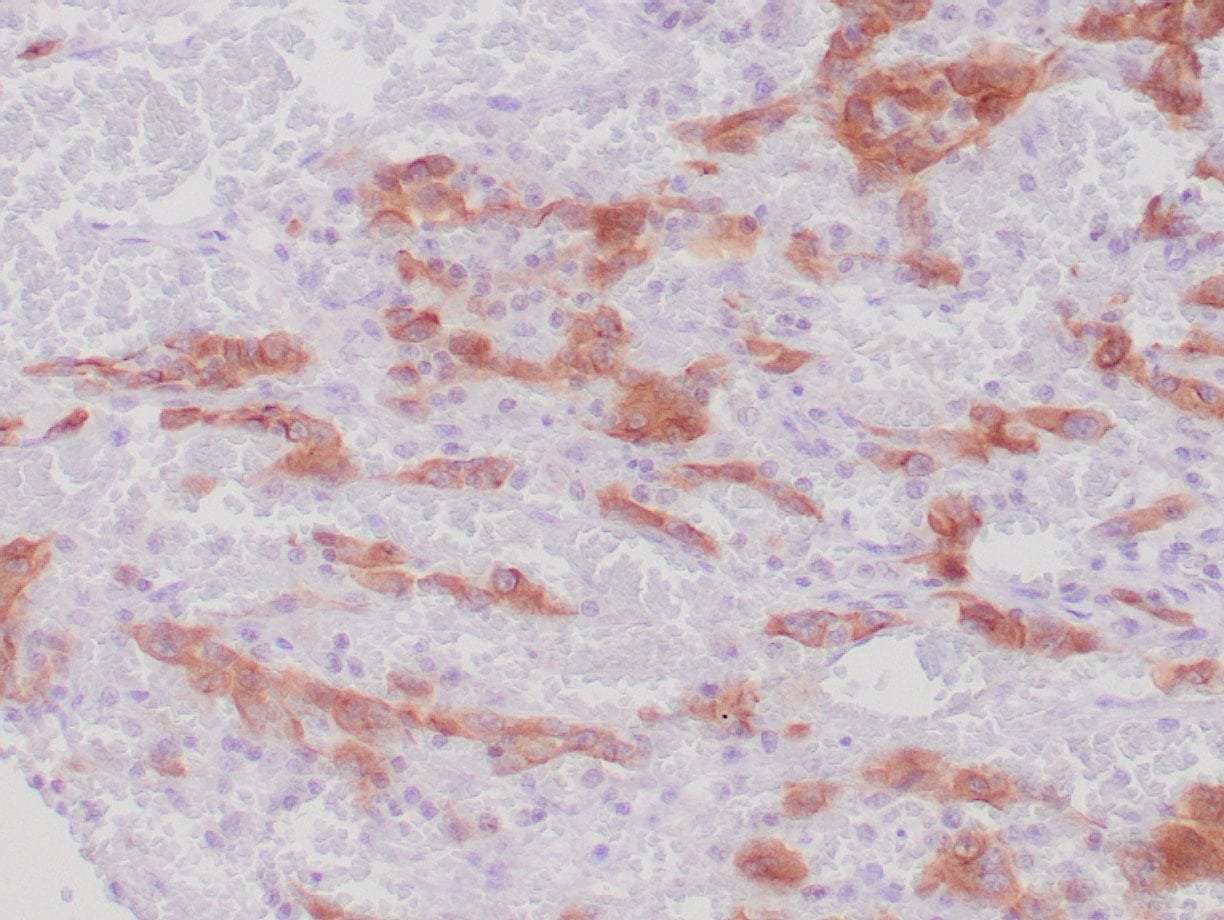 |
| Human lung adenocarcinoma stained with anti-ALK-1 antibody using peroxidase-conjugate and DAB chromogen. Note cytoplasmic stain of adenocarcinoma cells. |
Publications
| pmid | title | authors | citation |
|---|---|---|---|
| We haven't added any publications to our database yet. | |||
Protocols
| relevant to this product |
|---|
| IHC |
Documents
| # | SDS | Certificate | |
|---|---|---|---|
| Please enter your product and batch number here to retrieve product datasheet, SDS, and QC information. | |||
Only logged in customers who have purchased this product may leave a review.
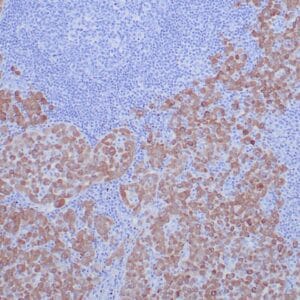
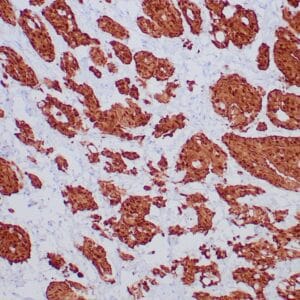

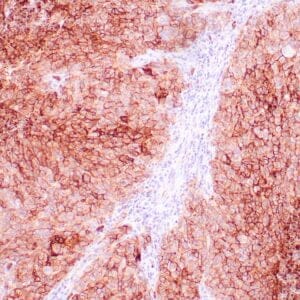
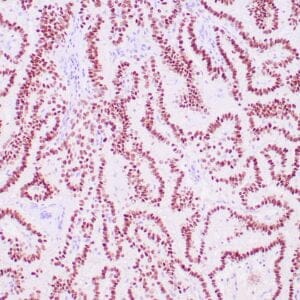
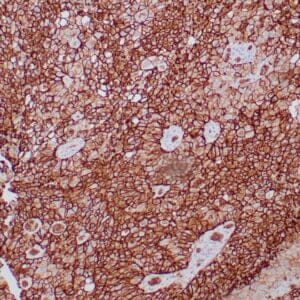
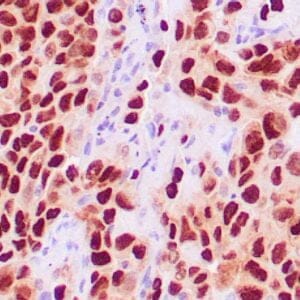
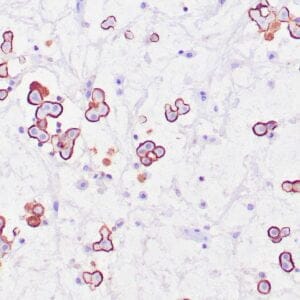
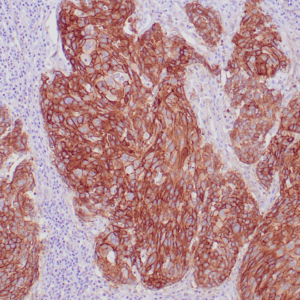
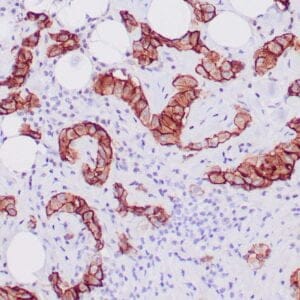


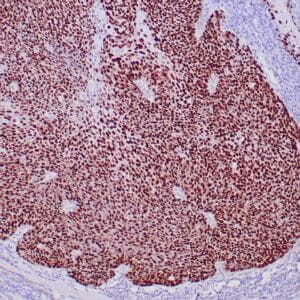
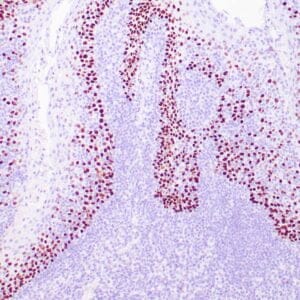
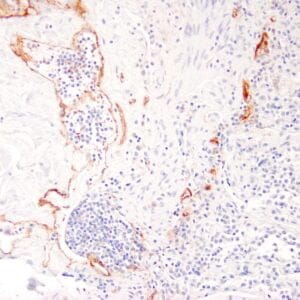
Reviews
There are no reviews yet.